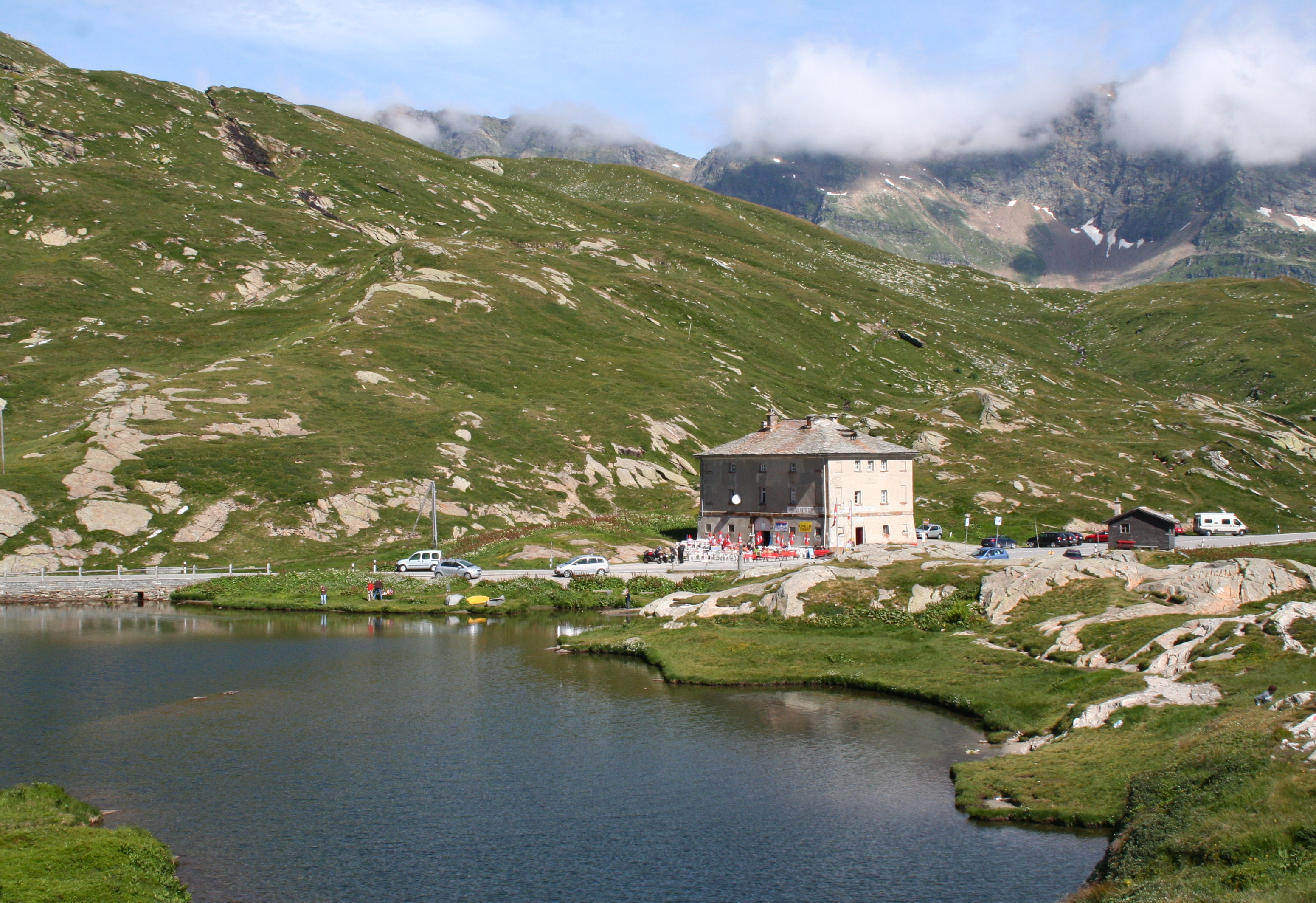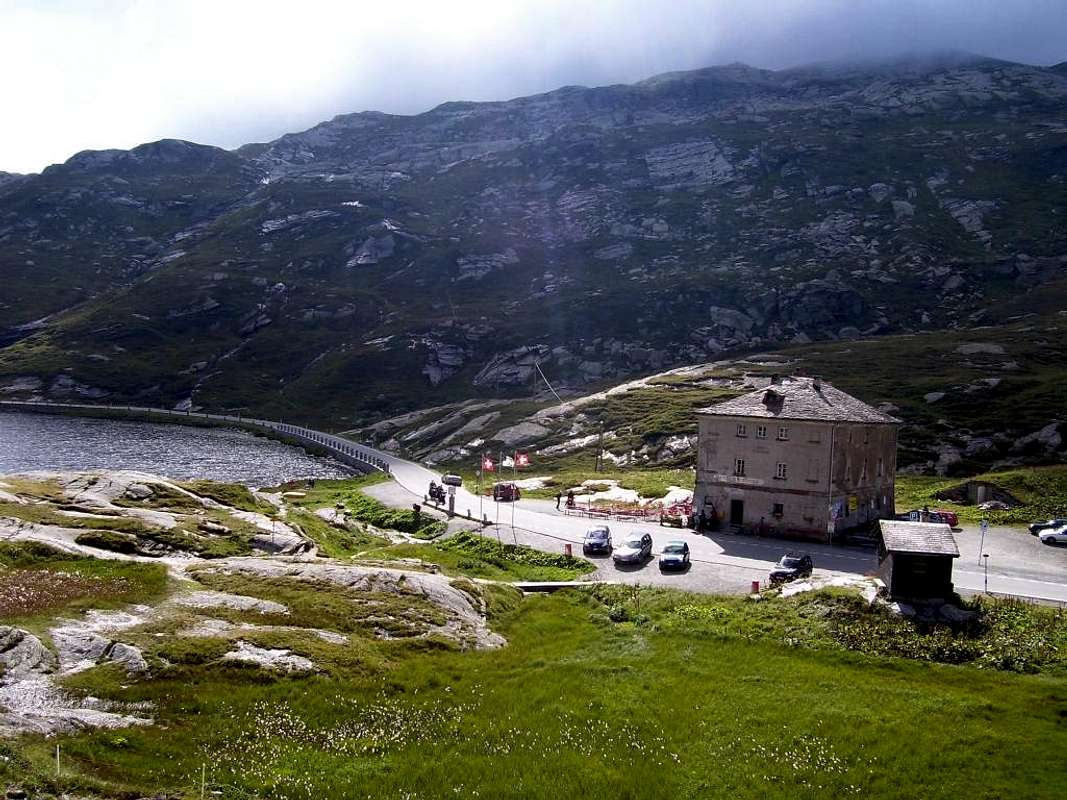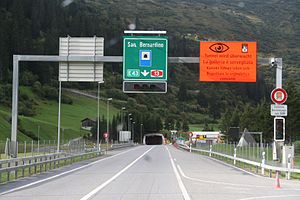San-Bernardino-Pass
San Bernardino Pass: pass with hospice
The San Bernardino Pass (Eng. little used even Santa Bernhardinpass or shortly Saint Bernardine, Italian Passo del San Bernardino ) is a mountain pass in the Swiss canton of Grisons, with a summit elevation of 2,065 m. It connects the valleys of the Rhine forest on the northern and Misox on the southern side of the main road 13 The air distance to the pass foot locations is four miles to Hinter Rhine ( at 1620 m located ) and 12 km to Mesocco (790 m). At the pass run the European watershed and the language border between German and Italian.
Name
The name was previously Mons avium or Vogelsberg called pass in the 15th century, when in honor of St. Bernardine of Siena, a chapel was built. In German, the historic Bernhardinpass ( Bernhardi mountain ) largely replaced the newly formed in the 20th century form the San Bernardino pass. Despite the name similarity is not related to the passes Grosser and Little St Bernard.
History and Description of route
The Romans used the broad, topographically simple pass crossing. Who used until the late middle ages path took about a kilometer east of the present pass road at the foot of Piz Uccello (Eng. horn bird ) along.
Increased deforestation increased the avalanche risk. To get from increasing in the 15th century transit traffic - the road through the Via Mala was expanded after 1473 - to benefit the people of the inner Rheinwald and their Misoxer had to act neighbors. They changed the route of the endangered slope foot away in the middle of the broad saddle, one marked by the ice age glaciers cut landscape with glaciated knobs and the small moors. In this period, the construction of the San Bernardino Church falls in 1450 on the south side of the pass. The one with paving and steps on the steep places very solidly built mule ( mulattiera ) has been well-preserved and now serves as a historic trail.
Around 1770 the Bernardine built the villages behind the Rhine, Nufenenpass and Mesocco from a motorable road. They eliminated that the remaining risk from avalanches passage at Geissberg who built the 1693 Old Landbrugg led by the Rhine to the west and crossed it took a greater slope in buying in Old Wali. At the summit, the path was also relocated to the west, so he overcame the saddle at the lowest point. Also this little road - misleadingly called Strada Romana - can be committed today.
On the pass there was 1799 when Laghetto Moesola to an armed conflict between a French army under General Claude- Jacques Lecourbe and the 500 men of the country Rheinwalder storm. The French defeated the Rheinwalder to flight, and marched in the valley.
1817 gave the cantonal government of the road builders and State Pocobelli Giulio ( 1766-1843 ) commissioned to develop a project with a cost estimate for a road of the Ticino cantonal border over the pass to Chur. Within a few days Pocobelli step from the 100 -kilometer route and put the controlled-system guide firmly. He then received by the cantonal government as a general contractor contract for the construction. Construction began on 18 September 1818. At the south ramp Pocobelli put the road on the slope on the right bank of the Moësa and spanned this at its narrowest point with the bridge Vittorio Emanuele.
Against the construction itself resisted the Lombardy and the Gotthard cantons of central Switzerland. Constructed in 1818-23 under the Kingdom of Piedmont-Sardinia significant participation until today the traffic serving road follows the path from 1770, but defused the slopes with many turns. At the summit a hospice was opened.
San Bernardino, pass
Stagecoach the San Bernardino line
San Bernardino tunnel
1967, the 6.6 kilometer-long San Bernardino tunnel, opened in Canton Graubünden between the villages behind the Rhine and San Bernardino. The tunnel first opened a year-round connection for the southern valleys of Grisons Misox and Calancatal in the capital, Chur and connects as part of the national road N 13 (now A13), the Eastern with the Southern Alps and the Ticino. He is the second most important after the Gotthard road crossing of the Alps of Switzerland.
At the time of planning the current traffic density was not in sight. The San Bernardino route was used for even more unexpected international heavy traffic as an alternative route to the A2, this especially after the accidental, temporary closure of the Gotthard tunnel in 2001. This, despite the route with gradients up to 8%, tight turning bends and narrow tunnel is unsuitable for trucks; the width of the road is tight and ventilation systems did not meet the requirements. The corresponding loads had made a renewal of the tunnel necessary. The restoration work began in 1991 - accompanied by security measures such as the introduction of the phase red - were completed in 2006. A separate escape and rescue tunnel was created as part of the restoration, and made the following modifications:
- Lowering the bottom of the central channel
- Renewal of the drainage system ( separation system ) and the ducts
- Renewal of the electromechanical devices
- Adjust operating and fire ventilation to today's requirements
- Creating an emergency escape tunnel (escape exits)
- Demolition and reconstruction of the road construction
- Renewal of the wall cladding panels
- Repair while maintaining the traffic
Origin of the old name Vogelsberg
The old name Vogelsberg may refer to the migratory birds that annually come here in large flocks. These have now discovered the tunnel as a 'shortcut'. Sometimes the traffic has to be stopped, so that the birds find their way undisturbed.
However, due to the same occupied designation " Vogelsberg " for the Rheinwaldhorn and the entire mountain range and the only commonly perpetrated in ancient times pass San Bernardino or early bird mountain pass in the central Alps above ( Gotthard Pass and Lukmanierpass were later opened ) the derivation of birds most likely a folk etymology. The name should rather from Indo-European * uek / UAC / uei ( k) latin " vacillare " as " be bent, bend, sway " originate, ie the entire massif and the source and Zieltal the pass traversal are different than usual crooked ( turned off ) to each other and are not aligned.










